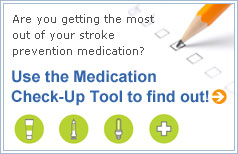|
I want to learn more about Stroke risk reduction I have atrial fibrillation (AFib) and want to learn more about stroke risk reduction I have high blood pressure and want to learn more about stroke risk reduction I have high cholesterol and want to learn more about stroke risk reduction I have diabetes and want to learn more about stroke risk reduction I have had a stroke or TIA ("mini-stroke") and want to reduce the risk of another stroke 
Talking to your doctorWorking with your doctor is an important part of managing your risk of stroke. Be prepared and learn how to talk to your doctor. What can I do to reduce my stroke risk?About 300,000 Canadians are living with the after-effects of a stroke, such as paralysis, vision problems, and difficulties with memory and thinking. But this doesn't have to be your story. Learn how you can reduce your stroke risk: Live a healthy lifestyleA few simple lifestyle changes can cut your stroke risk: Eat healthy (good nutrition) as directed by your doctorWhat to aim for: Each day, try to eat:
Don't eat too much sodium. Aim for:
How to make it happen:
Exercise as directed by your doctorWhat to aim for: Ask your doctor how much activity and what types of exercise are safe for you. How to make it happen: Check with your doctor before starting to exercise. If your doctor gives you approval to exercise, start slowly – even 10 minutes of activity is enough to get started. Then gradually work your way up to longer exercise times:
If you have medical conditions, check with your doctor before starting to exercise. Reach a healthy weight as directed by your doctorWhat to aim for:
or
How to make it happen:
Consult your doctor before making any changes to your physical activity or diet. Use alcohol in moderation as directed by your doctorWhat to aim for: Limit yourself to no more than 2 drinks a day, to a maximum of 10 drinks per week for women, and no more than 3 drinks a day, to a maximum of 15 drinks per week for men. (If you have liver disease, check with your doctor to find out your maximum recommended alcohol consumption.) How to make it happen:
Cut back if you are over the limit. If you are having trouble, talk to your doctor. Quit smoking as directed by your doctorWhat to aim for: Quit smoking and avoid second-hand smoke. If you are a non-smoker, do not start smoking. How to make it happen: When you're ready to quit, ask your friends and family to help, and speak to your doctor or pharmacist about options to help you quit. Tame your stress as directed by your doctorWhat to aim for: Understand and control the sources of stress in your life. How to make it happen:
Consult your doctor for assistance with stress management. *These lifestyle suggestions may not be appropriate for everyone. Check with your doctor to find out which lifestyle changes you should make to reduce your risk of stroke. Get medical conditions under controlHow do medical conditions increase stroke risk? The connection is simple - strokes can happen one of two ways:
Medical conditions that increase the risk of blood clots or bursting blood vessels will also increase your stroke risk. Which medical conditions could increase my stroke risk? Atrial fibrillation, also called AFib, affects about 350,000 Canadians. For people with AFib, the risk of a stroke caused by a blood clot is 3 to 5 times what it would be otherwise. AFib causes up to 15% of all strokes, and one-third of all strokes in people over 60. AFib causes the heart to beat abnormally. Blood pools in the heart, and when blood stands still it is more likely to clot. A clot from the heart could then travel through the bloodstream into the brain, where it could block a blood vessel, causing a stroke. To learn more, see atrial fibrillation and stroke risk reduction. Diabetes affected over 3 million Canadians in 2009, and this number is projected to rise to over 3.7 million by 2020. People with diabetes have a much higher death rate from stroke and heart attack than people without diabetes. The death rate from a stroke or heart attack is 3 times higher for men and 5 times higher for women if they have diabetes. Diabetes makes it harder for the body to break down sugar for energy. Sugar stays in the blood, where it damages the blood vessels, making them more likely to become narrow or blocked. Diabetes also increases the risk of high blood pressure, which increases stroke risk on it own. To learn more, see diabetes and stroke risk reduction. High blood pressure affects 20% of Canadians. Controlling high blood pressure can reduce your stroke risk by up to 40%. High blood pressure increases stroke risk by damaging blood vessels so they are more likely to clog or burst. To learn more, see high blood pressure and stroke risk reduction. About 40% of Canadians have high cholesterol. High cholesterol causes fatty deposits to build up in your blood vessels. This could block blood vessels in the brain and cause a stroke. To learn more, see high cholesterol and stroke risk reduction . Some people have other medical conditions that put them at risk of stroke. Talk to your doctor to learn more about your stroke risk and how to reduce the risk of a stroke. What should I do to get these conditions under control? Follow the treatment plan your doctor recommends, take your medications as directed, and have regular medical check-ups. Talk to your doctor about how to control your medical conditions. Use medications as directedDepending on your individual situation and medical conditions, your doctor may recommend that you take a variety of medication(s). Such medications include:
Click on the links above to learn more about the medications. Keep in mind that all medications may cause side effects. Some side effects are mild while others are more severe. Your doctor or pharmacist can help you understand what side effects to expect and how to manage them. Medications work best when they're taken regularly as recommended by your doctor. If you're having trouble with your medication, see your doctor or pharmacist for advice. Use the Medication Check-Up tool to make sure you're getting the most out of your medication and see whether it's time to talk to your doctor about your medication options. |
|
||||||||||||||||||||||||||||||||||||||||||||||||||||||||||||||||||||||||||||||||||||||||||||||||||||||||||||||||||||||||||||||||||||||||||||||||||||||||||||||||||||||||||||||||||||||||||||||||||||||||||||||||||||||||||||||||||||||||||||||||||||||||||||||||||||||||||||||||||||||||||||||||||||||||||||||||||||||||||||||||||||||||||||||||||||||||||||||||||||||||||||||||||||||||||||||||||||||||||||||||||||||||||||||||||||||||||||||||||||||||||||||||||||||||||||||||||||||||||||||||||||||||||||||||||||||||||||||||||||||||||||||||||||||||||||||||||||||||||||||||||||||||||||||||||||||||||||||||||||||||||||||||||||||||||||||||||||||||||||||||||||||||||||||||||||||||||||||||||||||||||||||||||||||||||||||||||||||||||||||||||
|
Hot Topics -
Bedwetting,
Depression,
Flu (Seasonal),
Healthy Skin,
Incontinence,
Multiple Sclerosis,
Psoriasis,
Stroke Risk Reduction
|
||
| Condition and disease information is written and reviewed by the MedBroadcast Clinical Team. |
||
|
|
The contents of this site are for informational purposes only and are meant to be discussed with your physician or other qualified health care professional before being acted on. Never disregard any advice given to you by your doctor or other qualified health care professional. Always seek the advice of a physician or other licensed health care professional regarding any questions you have about your medical condition(s) and treatment(s). This site is not a substitute for medical advice. © 1996 - 2024 MediResource Inc. - MediResource reaches millions of Canadians each year. |
|





